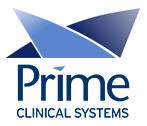
Intellect™
MANAGEMENT MENU OPTIONS

Aging
Report Aging
This option allows accounts receivable to be printed based on several aging criteria. This report is affected by the set up under Utility --►Category <Aging Method> and <Aging Group 1 (2, 3, and 4)>. Aging reports are run by clinic only.
The Aging report pulls data based on the patient’s current <Category> and primary insurance when the <All/Patient/Insurance> field is set to Insurance, All, Patient, Total, or Worker. For all other selections (such as ‘P1 Primary 1’, ‘P2 Primary 2’, ‘S1 Secondary 2’, etc.) the report data pulls from the charge history at the time of charge posting.
See details on opening and using the Print Aging screen.
Video Available: Click Aging Report to access the link. Depending on the system set up, the media player may need to be activated. Speakers need to be attached to the workstation to hear the instructions.
Note: To view the videos, log-in through the www.primeclinical.com website. Current support is required.
With this Management Report, Intellect provides the capability to print, export to Excel spreadsheet, Email, or Fax.
NOTE: When this report is exported to Excel, there are no headers or subtotals as there are when the report is sent to Intellect.
Updates:
Effective version 17.06.09, these changes were made to this report:
• Insurances with a zero balance (i.e., where the amount in the Total column would be zero) no longer display on the report.
• The report is now sorted according to the Description column instead of the Code column.
• The year 2017 was added.
In Versions prior to 9.12.13, when a patient has multiple insurances and a report is sorted by Insurance, all the insurances print in one line. For example, a patient has P1 insurance = ADP and P2 insurance = CHOICE, with charges as follows:
DOS 07/06/2010, th_insurance = CHOICE, Who = P2, balance = $240.00
DOS 11/??/2010, th_insurance = ADP, Who = P1, balance = $8550.00
If the report is run with Aging = Balance, All/Patient/Total = All, and Sorted By = Insurance, all the charges where Who = P1 and P2 print in one line with insurance code CHOICE and the total balance = $8790.00. It should print a line for the P1 charges with insurance code ADP and balance $8550.00, and a separate line on the report for insurance code CHOICE with the balance = $240.00
With the selections as follows, it printed correctly:
Aging = Balance
All/Patient/Total = All
Sorted By = Patient
Effective version 9.12.13, this report uses the Account Balance table, not the Treatment History table, which does not contain the P2 insurance company. When sorting by Insurance the program is therefore not able to separate the P1 and P2 charges. This is not an issue within the program, but is a limitation. PCS recommends clients should print the report separately for P1 balances and P2 balances.
To select the report to print P1 balances, complete as indicated:
Aging = Balance
All/Patient/Total = P1
Sorted By = Insurance
To select the report to print P2 balances, complete as indicated:
Aging = Balance
All/Patient/Total = P2
Sorted By = Insurance
1. To open the Print Aging screen in Intellect, go to Management --► Aging --►Report Aging
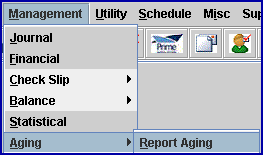
The Print AGING screen opens:
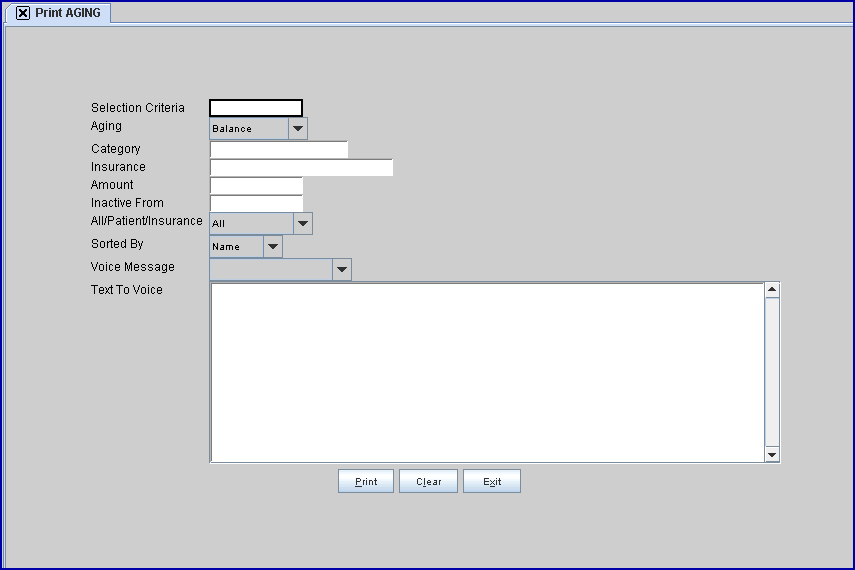
2. Selection Criteria 
2.1 This field allows accounts to be defined to print based on alphabetical criteria; i.e., the beginning letter of the patient's last name.
2.2 Leave this field blank to select all patients that meet any other criteria entered below OR define the parameter using a hyphenated alphabetical range such as A-L (see example below) to return patient accounts where the last name begins with any letters in the range of A-L.

3. Aging 
3.1 This field allows accounts to be defined to print based on account balance or aging group.
Keep in mind when making a selection in the <Aging> field that the selection determines the report.
Balance (A): ALL balances including credits, NOT including zero.
Group 1 (1): Any account that has a balance in Utility --► Category <Group 1>.
Group 2 (2): Any account that has a balance in Utility --►Category <Group 2>.
Group 3 (3): Any account that has a balance in Utility --►Category <Group 3>.
Group 4 (4): Any account that has a balance in Utility --►Category <Group 4>.
Zero Balance (Z): Patients with zero balance ONLY.
Debit Balance (P): All positive balances, NOT including credits or zero balances.
Credit Balance (N): All negative balances, NOT including credits or zero balances.
3.2 Accept the 'Balance' default OR use the drop-down list for an alternate selection.
Effective version 9.12.08 Modification: The single-character code choices on the drop-down lists for the <Aging> field have been replaced with complete word choices, making the code selection easier. For reference, in the red-boxed information above, the former single-character code choices are shown in parenthesis behind the new code choice.
3.3 To view the list of codes with descriptions, press the [F2] key OR click directly on the field. To view the list of only the codes, click on the arrow. To select, double-click on the correct code, OR use the ↑ (up) and ↓ (down) arrows to highlight the correct code, and then press the [Enter] key to select.
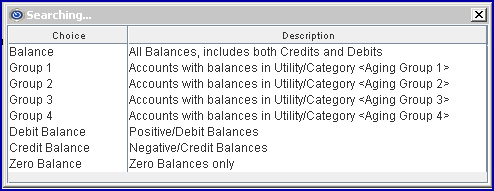
4.1 This field limits the report results by specific patient category.
4.2 Press [Enter] to bypass this field to request ALL categories.
4.3 Select a specific category by typing its' Utility --►Category <Category Code> in this field.
4.3.1 For example, enter 'COLL' in this field to view all accounts where the <Category> field in the patients registration screen is set to 'COLL.' Offices using a unique category code for collection accounts other than COLL should enter that code when printing the Detail Aging report.
4.4 This field is referenced in reports based on the setting of the <All/Patient/Insurance> field.
5. Insurance 
5.1 This field limits the report results by specific patient insurance.
5.2 Press [Enter] to bypass this field to request ALL insurance companies.
5.3 Select a specific insurance by typing its' Utility --►Insurance <Insurance Co. Code> in this field.
5.4 This field is referenced in reports based on the setting of the <All/Patient/Insurance> field.
6. Amount 
6.1 This field limits the report results by setting a specific minimum dollar balance.
6.2 Press [Enter] to bypass this field to accept the default of 0.00, requesting all dollar amounts be included in this report.
6.3 Enter a dollar amount to request all A/R that meet and/or exceed the amount entered to be included in this report.
7. Inactive From 
7.1 This field limits the report results to those patients who have not been seen since the date entered in this field.
7.2 Press [Enter] to bypass this field to request all patients meeting the other requested criteria.
8.1 This field determines whether the report data is pulled from the patient demographics or insurance information, or from the charges history.
8.1.1 If options All, Insurance, Patient, Total, or Worker are selected, the report data is pulled from the patient demographics or insurance information. For all other selections (i.e., P1 Primary 1, S2 Secondary 2, T3 Tertiary 3, Statistical, etc.), the report data is pulled from the charge history at the time of charge posting.
8.2 Select the sorting order from the drop-down list.
8.3 Accept the 'All' default OR use the drop-down list for an alternate selection.
Effective version 9.12.08 - Modification: The single-character code choices on the drop-down list for the <All/Patient/Insurance> field have been replaced with complete word choices, clarifying the code selection.
8.3.1 If options All, Patient, Insurance, or Total are selected, the insurance code printed on the report, and used in sorting by Insurance, is always the current P1 insurance.
8.4 To view the list of codes with descriptions, press the [F2] key OR click directly on the field. To view the list of only the codes, click on the arrow. To select, double-click on the correct code, OR use the ↑ (up) and ↓ (down) arrows to highlight the correct code, and then press the [Enter] key to select.
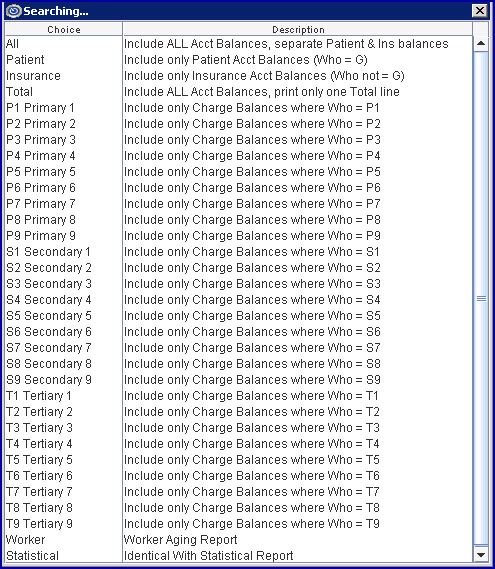
9. Sorted By 
9.1 Select the sorting order from the drop-down list.
9.2 Accept the 'Name' default OR use the drop-down list for an alternate selection.
• Effective version 9.12.08 - Modification: The single-character code choices on the drop-down lists for the <Sorted By> field were replaced with complete word choices, making the code selection easier. For reference, the new codes correspond to the old codes as follows: Name - N, Insurance - I, Account - A, Category - C, and Balance -B.
• Effective version 9.12.08 - New option added: Balance. Balance sorts the records by the balance, listing highest to lowest.
• Effective version 9.12.18 - Modification: In versions prior to 9.12.18 when selecting either All, Patient, Insurance, or Total in the <All/Patient/Ins> field and selecting Insurance in the <Sort> field, the patient names listed under each insurance company code were not in alphabetical order. As of version 9.12.18, the patient names within each insurance company code are displayed in alphabetical order.
9.4 To view the list of codes with descriptions, press the [F2] key OR click directly on the field. To view the list of only the codes, click on the arrow. To select, double-click on the correct code, OR use the ↑ (up) and ↓ (down) arrows to highlight the correct code, and then press the [Enter] key to select.

Note: When sorting by Insurance for reports All, Patient, Insurance, or Total, Intellect uses the patient table primary insurance field which is not accessible on the patient screen. When a new insurance is added for the patient, or the existing patient insurance code modified, the patient table primary insurance field is updated. Report codes P1 Primary 1, P2 Primary 2, P3 Primary 3, S1 Secondary 1, S2 Secondary 2, etc. use the patient’s insurance at the time the charge was posted to sort by insurance.
10.1 Effective version 13.06.24 - New field.
10.2 Once set up, this field can cut down on time for offices calling patients to let them know a payment has not been received, or that there is an outstanding balance, or to request that patients contact the office to schedule payment options. For example, an MP3 file format message could be recorded to let patients know their account is 30/60/90 days past due and to please remit payment.
10.3 The drop-down list for this field varies. Initially, it has two choices of 'blank' and Text, but other options may be added:
• Blank: If 'blank' is selected, a report prints.
• Text: If 'Text' is selected, a message must be entered in the <Text to Voice> field to be converted to a voice message and read by Twilio. Messages may be in any language that Twilio supports. As of 06/2013, English, Spanish, French, and German are supported. To send a message in a language Twilio does not support, the message needs to be recorded in MP3 file format.
• Any option other than 'blank' or 'Text': Additional options, if any, display the names of MP3 files that have been recorded and subsequently added to the drop-down list. When an MP3 file is selected, instead of printing a report, Intellect uses the selected MP3 file when making phone calls to selected patients. See MP3 set up information, or contact Prime Clinical support.
10.4 Voice Messages are sent based on selected criteria; if the criteria are not met, the message is not sent.
11.1 Effective version 13.06.24 - New field.
11.2 This field is used with the <Voice Message> field. For this option to work with voice messages, clinics must have a Twilio account, and Twilio must be set up in Intellect. To open a Twilio account, go to www.twilio.com. See Voice Message Set Up (sections A and B) for additional information.
Note: Text to Voice messages are sent based on selected criteria; if the criteria are not met, the message is not sent.
11.3 When the 'Text' option is selected for the <Voice Message> field, the message typed in this field is read by Twilio when a call is made. Messages may be in any language that Twilio supports. As of 06/2013, English, Spanish, French, and German are supported. To send a message in a language Twilio does not support, the message needs to be recorded in MP3 file format.
11.4 Enter the message for Twilio to read. So that the message does not begin the instant the call is initiated, create a pause by entering 5 or 6 commas preceding the message. For example: ,,,,,Good Morning. This is Doctor Smith's office letting you know your payment has not been received. Please call our office to schedule payment options.
11.5 The text message may include database fields like PA_FIRST_NAME, AC_BALANCE, which Intellect replaces with the appropriate value to personalize the message for each patient when it is read by Twilio. Right-click in the <Text to Voice> field to access available database fields. Simply double-click on the appropriate option to select it. A partial list of database fields:
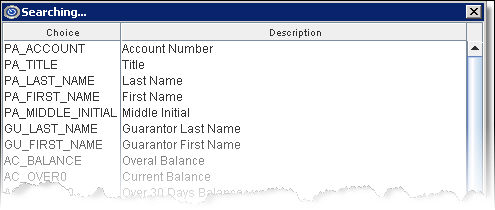
For example, type the message and right-click to insert a database field for personalized information. When the following sample message is read by Twilio, the data base fields in the message are replaced by the patient’s first name, the total of his/her current balance, and the amount owed that is thirty days past due. Note: It is recommended that the message be typed in lowercase.
,,,Hello %{PA_FIRST_NAME} Your current balance is %{AC_OVER0} with a balance of %{AC_OVER30} thirty days overdue.
Text-to-voice messages may be used in automation too. To have text-to-voice messages automated, please contact Prime Clinical Support.
12. When the information is completely entered, select an option:

12.1 Click [Print] OR press [Enter] to display the Print Aging Report dialog box:
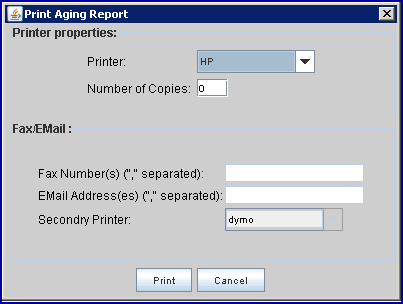
12.1.1 Printer Properties:
12.1.1.1 Printer: The default printer for the logged-in clinic and password is selected. To select a different printer, either click on the arrow, OR press the → (right arrow) on the keyboard to view the list of printer codes. In our example, the defaulted Printer is HP. This is just an example of a printer name and may or may not be set up on the system.
To select the printer type, click on the code, OR use the ↑ (up) and ↓ (down) arrows to highlight the correct code; then press the [Enter] key to select.
12.1.1.2 Number of Copies: This field defaults to either 0 (zero) or 1. Both print 1 copy. To print more than one copy, enter the number of copies.
12.1.2 Fax/Email:
In addition to printing reports, Intellect provides the capability to export reports to Email, Fax, Disk, or Archive. A secondary printer may also be selected, if one is set up, by clicking on the arrow to display the drop-down list.
12.1.3 Select the [Print] button to send the request to the printer (or as a Fax or email).
12.1.4 Select the [Cancel] button to clear the screen and return to the Print Aging screen without saving or printing.
12.2 Select [Clear] to remove any information already entered on the screen and return the focus to the <Selection Criteria> field without saving..
12.3 Select [Exit] to clear the screen and return the focus to the main Intellect screen without saving.
Age Account
This option is used to physically age the patients' accounts according to their set up under Utility --►Category <Aging Method> and <Aging Group 1 (2, 3, and 4)>. Your system comes with this feature automated, so accounts are aged each night.
To age accounts manually, select the Age Account menu option (see below) to begin aging the accounts.
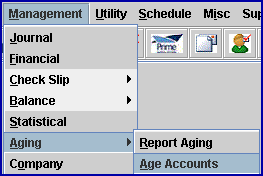
The length of time this process takes depends on the number of patient accounts. The screen first displays this prompt:

Then the Process displays:

Sample Management Aging Reports based on the <Aging> field